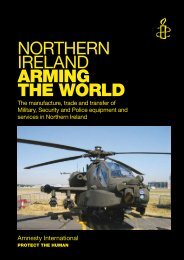CROWD CONTROL TECHNOLOGIES - Omega Research Foundation
CROWD CONTROL TECHNOLOGIES - Omega Research Foundation
CROWD CONTROL TECHNOLOGIES - Omega Research Foundation
You also want an ePaper? Increase the reach of your titles
YUMPU automatically turns print PDFs into web optimized ePapers that Google loves.
4.1.4 Hazards Of Pyrotechnic & Blast Chemical Irritant Delivery Systems. Blast injuries from<br />
fragmentation devices are far from uncommon. The fact that pyrotechnic devices are incendiary<br />
creates both a risk of burn injuries and the initiation of a fire. For example 96 cases of acute burn<br />
injuries were reported when teargas was used against refugees in a Hong Kong Detention centre. 143<br />
The Material safety sheet on CS assigns a flammability rating of 4 (on a scale 0-4) and some<br />
commentators now ascribe incendiary CS grenades as a large contributor to the conflagration which<br />
burned the Branch Davidian Compound and its inhabitants at Waco, Texas, in 1993 144 .<br />
4.1.5 Training & Professional Codes Of Conduct. The notion that such chemical irritants are nonlethal<br />
is based on an assumption that they are used in accordance with manufacturers instructions and<br />
not in enclosed spaces. When disputes over appropriate usage occur, there needs to be a clear line of<br />
accountability. In Canada, when an innocent man was sprayed with pepper-gas and suffered injuries<br />
to his eyes and lungs he sued the local police because of the longer term effects (bronchial asthma and<br />
reactive airways dysfunction syndrome). The police officers in Ottawa defended the claim by filing a<br />
third party claim against the manufacturer Defense Technology (Def-Tec). However, the company<br />
claimed the fault was that of the police for failing to train its officers properly. The company alleged that<br />
)police negligently caused the product to be activated for an excessive period of time 145 .(<br />
In the UK , complaints about tear gas by members of the public have ballooned. In the year up to<br />
March 1998, the Police Complaints Authority received 425 complaints about the sprays compared to<br />
254 in the previous year. The UK guidelines insist that CS spray was introduced only for self defence,<br />
yet the UK Police Complaints Authority Report already referred to, revealed that in nearly 40 % of the<br />
cases in their study, it was not used primarily in self defence. Similarly, the original guidelines said the<br />
sprays would not be used in crowd control, however, the new Association of Chief Police Officers<br />
(ACPO) guidelines enable it to have a public order role. Such drift in the ground rules which originally<br />
legitimated the introduction of this weapon illustrates the threat to civil liberties well. If Chemical irritant<br />
weapons are not to become indiscriminate weapons then codes of conduct should have legal weight.<br />
4.2 Kinetic Impact Weapons - Health and Safety Issues. In compiling this report it has become clear<br />
that there is a lack of independently conducted research into kinetic impact weapons. The country that<br />
has seen, by far, the greatest use of kinetic impact weapons in Europe is Northern Ireland. More data<br />
and medical reports exist from the usage there than in any other country and will be used as a baseline<br />
for the discussions that follow.<br />
In January 1977, the UK Secretary of State for Defence was asked about the research on the<br />
likely death and injury rates from rubber and plastic bullets carried out prior to their introduction. His<br />
reply referred to a report by four surgeons working at the Victoria Hospital in Belfast in 1972 - two years<br />
after rubber bullets had been used in Northern Ireland - and said that comparable data for plastic<br />
bullets was not available 146 . The UKs inability to carry out basic safety testing was revealed by US<br />
military scientists who developed a comprehensive set of procedures to evaluate blunt trauma impact<br />
devices to establish their injury potential and the relevant characteristics that would enable them to<br />
operate safely. 147 The US researchers also found that the injury potential of a projectile was dependant<br />
on its kinetic impact energy. The researchers described Impact energies below 15 foot lbs (20.3<br />
Joules) are safe or low hazard (provided the projectile is large enough not to damage the eyes);<br />
between 30 and 90 foot pounds (40.7 - 122 Joules) as a dangerous area for impact energy and<br />
impacts above 90 foot pounds (122 Joules) as being in the severe damage region. 148 The present<br />
study has assessed a number of currently deployed riot weapons against this baseline for safety (see<br />
Table 2). Figures for different types of kinetic energy weapons, including eight from Europe, are<br />
presented. At the range that the weapon is intended to strike its target, seven of the European<br />
weapons were in the )severe damage( region and one was in the )dangerous( region. Thus nearly all<br />
of the kinetic energy weapons currently authorised for use in Europe operate in the severe damage<br />
region and are therefore potentially lethal. One European government has announced that it will fund<br />
research into a less damaging alternative. Given the findings of this report this research be reported in<br />
public forums and not, as in the past, kept secret. 149<br />
xxvi




